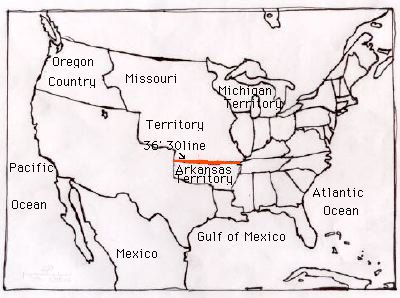
Topic: Missouri Compromise

Topic: Missouri Compromise
| Table of Contents | |
| Overview
Vocabulary Terms and Identifications |
Important
Maps
Quiz |
Overview: The Missouri Compromise
Conflict between the states during the first fifty years of the US history began when Eli Whitney invented the cotton gin. The cotton gin increased the demand for southern cotton, which increased the need for slaves to pick the cotton. Laws were passed to restrict free blacks in the 1830s. The constitution contained the 3/5 compromise between slave and free states, over the issue of representation and taxation were other documents that were over slavery in the territories gained by the United States were the Missouri Compromise and the Compromise of 1850.
The Missouri Compromise drew a line from the 36' 30 latitude line. It said that north of that line slavery would be banned forever. South of that line slavery would be permitted. Missouri compromise was a plan agreed upon by the United States congress in 1820 to settle the debate over slavery in the Louisiana Purchase area.
The House of Representatives aroused anger in the south by passing a bill to admit Missouri with the provision that no more slaves could be brought into the state. Slavery was legal in the territory of Missouri, and about 10,000 slaves lived there. Most people expected Missouri to become a slave state and it did. The Missouri compromise was signed by James Monroe.
Maine became a free state in 1820, no slavery was permitted. The
senate passed a bill allowing Maine to enter the union as a free state
and Missouri to be admitted without restriction on slavery. At first
they weren't sure if they wanted Maine to become a free state because they
wanted to create the balance of power between the states in the Senate,
so they let Maine in as a free because Maine used to be part of Massachusetts
before the Missouri Compromise. They made an exception when they
decided that they were going to admit Missouri as a slave state for the
same reason that they wanted to keep the balance of power between the states
in the Senate.
Vocabulary and Identifications
1) Henry Clay: He was speaker in the House of Representatives when the Compromise was passed. It was mostly his idea.
2) Maine: Entered the Union as a free state in 1820.
3) Missouri: Entered the Union as a slave state in 1821.
4) Popular Sovereignty: the idea that the people of a state or territory could vote and make the decision on whether or not to introduce slavery into their area.
5) Sectionalism: Devotion to that interests of ones own section over those of the nations a note.
6) Banned:
not permitted; not allowed

The Missouri Compromise prohibited slavery north of the 36 30 line.
Insert your questions here.
1) The Missouri Compromise allowed Missouri to become
A. free state
B. slave state
C. territory
D. American colony
2) What did the Missouri Compromise say?
A. No slavery in the United States
B. Gave women the right to vote
C. to stop other countries from interfering with
the European affairs
D. No slavery north of the 36'30 degree line, south
of that line slavery was permitted
3) Who was president when the Missouri Compromise was written?
A. James Monroe
B. Abraham Lincoln
C. Thomas Jefferson
D. James Madison
4) When was the Missouri Compromise written?
A. 1870
B. 1840
C. 1821
D. 1820
5) What does sectionalism mean?
A. Devotion
to that interests of ones own section over those of the nations a note.
B. Choosing presidents
C. The process in which states become free
D. Disagreeing about letting states become free
or slave
6) What year did Missouri become a slave state?
A. 1830
B. 1820
C. 1821
D. 1825
7) What line of degree is the latitude line that contained slavery
to the South?
A. 36' 32
B. 32' 30
C. 36' 30
D. 36' 29
8) What part of the degree line was free except for Missouri?
A. north
B. south
C. east
D. west
9) Who was the speaker in the House of Representatives during the Missouri
Compromise?
A. Thomas Jefferson
B. Henry Clay
C. James Madison
D. James Monroe
10) Who invented the Cotton Gin?
A. Eli Whitney
B. Thomas Edison
C. Thomas Jefferson
D. Carolus Linneaus
1) B.
2) D.
3) C.
4) D.
5) A.
6) C.
7) C.
8)
http://www.britannica.com/
Missouri Compromise- Britannica
World Book
This page is part of a web project developed by Mr. Cassutto's 7th grade US History class at Sterling Middle School
Student authors:
Amanda L.
Carolina C.
George Cassutto's Cyberlearning
World
[Lesson Plan of the Day] [Cassutto Memorial] [About the Author] [Search] [Civics Lesson Plans]